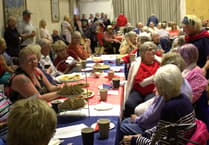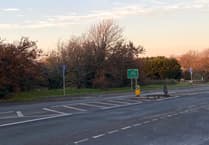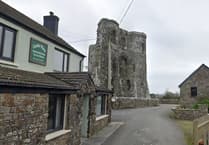Guy Manning came to the Arts Club to give a demonstration of oil painting. He paints on canvas stretched over a frame and staple gunned in place. Canvas is a strong material - in fact the word comes from the French for a sturdy material.
He then primes the canvas with gesso, a chalk-based paint. The next step is to add the base colour. Guy actually makes these himself from earth local to the landscape he is painting. He has earth from a farm down Trefloyne Lane. He sieves it, pounds it, and sieves it again. It then gets baked at about 60 degrees. Many ochre paints such as burnt sienna come from the oxidation of iron ore.
Guy then adds linseed oil (previously walnut oil was used) to make a paste. This is now a paint, a coloured hue mixed with some medium such as oil or acrylic, and it is the base colour used in this painting.
Tempura is an older medium than oils. The hue is mixed with egg instead of oils. It needs to be on a rigid surface such as a panel, but you can possibly get finer detail than with oils.
He used a French decorator’s brush designed for cutting in windows to map out the basics of the painting. The hue which made ultramarine (over the sea) came from over the Khyber pass which was under English control, so the French government gave a prize for developing a synthetic version. This is now known as French Ultramarine and is around £6 a tube, whereas the original ultramarine is £100 a tube!
Guy used the paint thinned with white spirit to start adding the sky. He slowly lessens the amount of turpentine or white spirit as he adds layers to the painting.
Adding white to a colour gives a tint, and Guy added a hint of a tint of blue, and then a more brown mix for the storm clouds. Indian Red and Burnt Sienna added some mud.
With a Blue Peter flourish, Guy then produced a previously prepared canvas worked up to the point where the darker base layers were completed and he was able to start adding the lighter layers. Using a flat brush, he explained how revolutionary the invention of the metal collar was for brush-making. He added some light blue and terracotta - tonally similar, even though they are opposite ends of the colour spectrum. A bit of cadmium yellow, also opposite to the blues and purples, gives a wow factor.
Guy slowly adds layers so that the spaces between the colour splodges get smaller and smaller, like putting postage stamps over a page and then adding more over the gaps and continuing to do this until there are no gaps.
He studied sculpture in art college, but afterwards went back to drawing. He spent 14 years as an art teacher and started painting. He threw himself into painting full-time for a year while he got to grips with dealing with galleries and on-line selling, and found it a struggle that he only now feels he has overcome. He uses oil by preference, only reaching for acrylic if he is doing a mural or something similar.
Guy had some paintings on display, including several of the postcard sized paintings he completed when he challenged himself to do a painting a day for a year. The evening was a fascinating insight into a painter’s world.
A.D.





Comments
This article has no comments yet. Be the first to leave a comment.